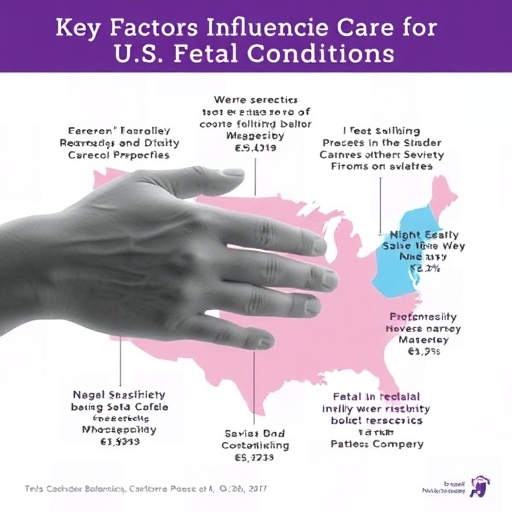In the rapidly evolving landscape of perinatal medicine, addressing the multifaceted needs of families confronting fetal conditions has emerged as a paramount challenge. A groundbreaking conceptual framework recently presented by Wilpers and Lorch in the Journal of Perinatology offers an innovative lens through which to understand the diverse drivers influencing care delivery and health outcomes for these vulnerable populations in the United States. This study, published in 2025, redefines existing paradigms by integrating clinical, social, and systemic factors into a cohesive model that underscores the complexity of perinatal care.
At the heart of this framework lies the recognition that fetal conditions—ranging from genetic anomalies to structural malformations—do not occur in isolation. Instead, their impacts ripple through intricate networks of maternal health, healthcare infrastructure, socio-economic status, and psychological support systems. Wilpers and Lorch meticulously dissect these layers, emphasizing that outcome variability often stems from interactions among these drivers rather than from the fetal condition alone. This insight marks a decisive shift away from purely pathophysiological models toward more holistic, person-centered approaches.
Central to the framework is a sophisticated understanding of how care is accessed and delivered across different healthcare environments. The authors reveal stark disparities in service provision, linked to geographic location, insurance coverage, and institutional resources. In many areas, referral pathways remain fragmented, impeding timely diagnosis and intervention for families affected by fetal anomalies. The model highlights the critical role of coordinated, multidisciplinary teams to bridge these gaps, advocating for integrated care pathways that encompass obstetrics, neonatology, genetics, and psychosocial support.
.adsslot_3C7ElihS8e{ width:728px !important; height:90px !important; }
@media (max-width:1199px) { .adsslot_3C7ElihS8e{ width:468px !important; height:60px !important; } }
@media (max-width:767px) { .adsslot_3C7ElihS8e{ width:320px !important; height:50px !important; } }
ADVERTISEMENT
Furthermore, the conceptual model introduces a nuanced perspective on decision-making processes faced by expectant parents and healthcare providers. Ethical, cultural, and informational factors converge to shape choices regarding pregnancy management, interventions, and postnatal care. Wilpers and Lorch illuminate the often-overlooked emotional labor borne by families navigating uncertain prognoses, advocating for enhanced counseling strategies that foster shared decision-making and mitigate decisional regret.
Importantly, the research explores how advances in prenatal diagnostics, including high-resolution imaging and genomic sequencing, have transformed not only clinical practice but also the emotional and psychological dimensions of care. While early and precise diagnoses can facilitate proactive planning, they also raise complex ethical dilemmas about intervention thresholds and quality of life considerations. The framework encourages ongoing evaluation of how technological innovations modulate care trajectories and emotional outcomes.
Socioeconomic determinants loom large within the framework, underscoring how financial constraints, educational disparities, and systemic racism intersect to shape both access to care and long-term health trajectories. Wilpers and Lorch advocate for health policies that directly address these inequities, arguing that perinatal outcomes can be improved only through structural reforms that expand equitable access to advanced diagnostic and therapeutic services.
The model also explicitly incorporates the role of perinatal palliative care, a rapidly growing subspecialty that offers holistic support to families confronting life-limiting fetal diagnoses. Through compassionate symptom management, psychosocial support, and advance care planning, palliative frameworks help ameliorate suffering and uphold dignity, even amid tragic prognoses. By situating palliative care as an integral component rather than an adjunct, the authors call for its broader adoption and standardization within perinatal care systems.
Another salient feature of this conceptual framework is its attention to healthcare provider wellbeing and communication dynamics. The emotional toll borne by clinicians managing complex fetal cases can influence care quality and interprofessional collaboration. Wilpers and Lorch highlight the need for structured institutional supports, including ethics consultations, debriefing sessions, and resilience training, to sustain providers’ capacity for empathy and optimal clinical judgment.
Moreover, this framework extends beyond immediate perinatal care to encompass long-term outcomes, including neurodevelopmental trajectories, family functioning, and societal integration for children born with fetal conditions. Longitudinal follow-up and coordinated care plans emerge as essential elements, fostering sustained health and psychosocial wellness. The authors emphasize that outcome assessments must incorporate both traditional medical metrics and broader quality-of-life indicators, tailored to individual family goals.
Technological integration within healthcare systems also features prominently in the proposed model. Wilpers and Lorch advocate for leveraging electronic health records, telemedicine, and decision support tools to streamline information sharing and enhance personalized care. Especially in underserved regions, these digital innovations can bridge access gaps and facilitate continuous monitoring, empowering clinicians and families alike.
Crucially, the framework underscores the importance of community and peer support networks. Families facing fetal conditions often encounter isolation and stigma. By fostering connections with advocacy groups, counseling services, and experiential peer support, holistic care can be extended beyond the clinical setting—mitigating emotional distress and enhancing coping capacities.
This conceptual approach paves the way for groundbreaking research endeavors as well. By operationalizing the drivers of care and outcomes into measurable constructs, Wilpers and Lorch provide an empirical foundation for future studies examining interventions and policy changes. Such investigations can elucidate causal pathways and yield evidence-based guidelines that optimize resource allocation and care design.
The study also contemporizes existing theories of perinatal care by integrating dynamic systems thinking. Recognizing that care delivery and outcomes emerge from complex, adaptive interactions within healthcare ecosystems, the framework calls for flexibility and responsiveness in both clinical and policy environments. This paradigm shift encourages iterative improvement processes informed by ongoing data collection and stakeholder engagement.
In sum, the conceptual framework presented by Wilpers and Lorch addresses a critical knowledge gap by articulating the interconnected web of factors shaping care experiences and outcomes for families confronting fetal conditions in the U.S. Its comprehensive scope and forward-thinking orientation invite a reimagining of perinatal healthcare toward models that are equitable, compassionate, and evidence-informed. As perinatal medicine advances into the mid-21st century, such multidimensional frameworks will prove indispensable for guiding clinical practice, policy development, and research priorities alike.
By confronting the complexity inherent in fetal conditions with scientific rigor and empathetic insight, this study has the potential to catalyze transformative change. Healthcare stakeholders, from clinicians to policymakers, are called upon to harness these insights in creating systems where every family receives not only medical excellence but also the dignified, holistic support they deserve. This work stands as a vital milestone charting the future course of perinatal care in America.
Subject of Research: Drivers of care and outcomes for people facing fetal conditions in the United States; development of a conceptual framework integrating clinical, social, and systemic factors.
Article Title: Drivers of care and outcomes for people facing fetal conditions in the United States: a conceptual framework.
Article References:
Wilpers, A.B., Lorch, S.A. Drivers of care and outcomes for people facing fetal conditions in the United States: a conceptual framework. J Perinatol (2025). https://doi.org/10.1038/s41372-025-02340-y
Image Credits: AI Generated
DOI: https://doi.org/10.1038/s41372-025-02340-y
Tags: access to healthcare for fetal conditionsfetal conditions carehealthcare disparities in fetal carehealthcare infrastructure and fetal healthinnovative frameworks in perinatal carematernal health impacts on fetal conditionsoutcome variability in fetal careperinatal medicine challengesperson-centered approaches in perinatal medicinepsychological support for families with fetal conditionssocio-economic factors in perinatal outcomes





